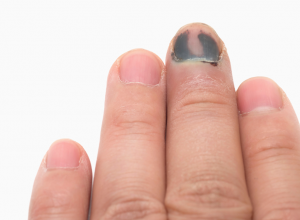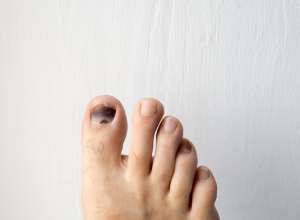
Subungual Hematoma
Subungual hematoma — commonly referred to as black toenail, runner's toe and tennis toe when it affects the nails on the feet — is when a pool of blood collects underneath a nail and leaves it discolored or black.
Symptoms
In addition to a toenail or fingernail that appears black or burgundy in color, subungual hematoma can also cause intense, throbbing pain if the thickened blood builds pressure against the nail. Other symptoms of black toenail or fingernail include redness, swelling, ingrown toenails and possibly an odorous discharge.
Causes
There are many causes of black toenails, but trauma or a crush injury is the most common. Runners are more susceptible to developing subungual hematoma, as their feet sometimes repeatedly strike the tip of their shoes. The discoloration that develops is essentially a bruise.
Treatment
Usually black toenails either grow out or fall off and then regenerate on their own, a process that can take about six months to complete. Sometimes medical attention is necessary, especially in cases where the black toenail is causing excruciating pain or if the discoloration covers more than 25% of your nail. The latter could be a sign that the nail bed is severely lacerated or that there is exposed bone underneath the nail — both of which can lead to a bone infection (osteomyelitis) that could result in loss of the toe.
If medical treatment is sought, you can expect a couple of different decompression methods that will help drain the blood, including using a needle to perforate the nail, using a heated wire or carbon laser to burn a hole in the nail or complete nail removal.
In some cases, toenail discoloration can be caused by a fungus, so it’s important to get any discoloration of nails inspected by a podiatrist. Since a fungal infection can spread and be difficult to treat, it’s best to have a podiatrist help you stop the fungus in its tracks early on.
Notice concerning medical entries:
Articles having medical content shall serve exclusively for the purpose of general information. Such articles are not suitable for any (self-) diagnosis and treatment of individual illnesses and medical indications. In particular, they cannot substitute for the examination, advice, or treatment by a licensed physician or pharmacist. No replies to any individual questions shall be effected through the articles.








